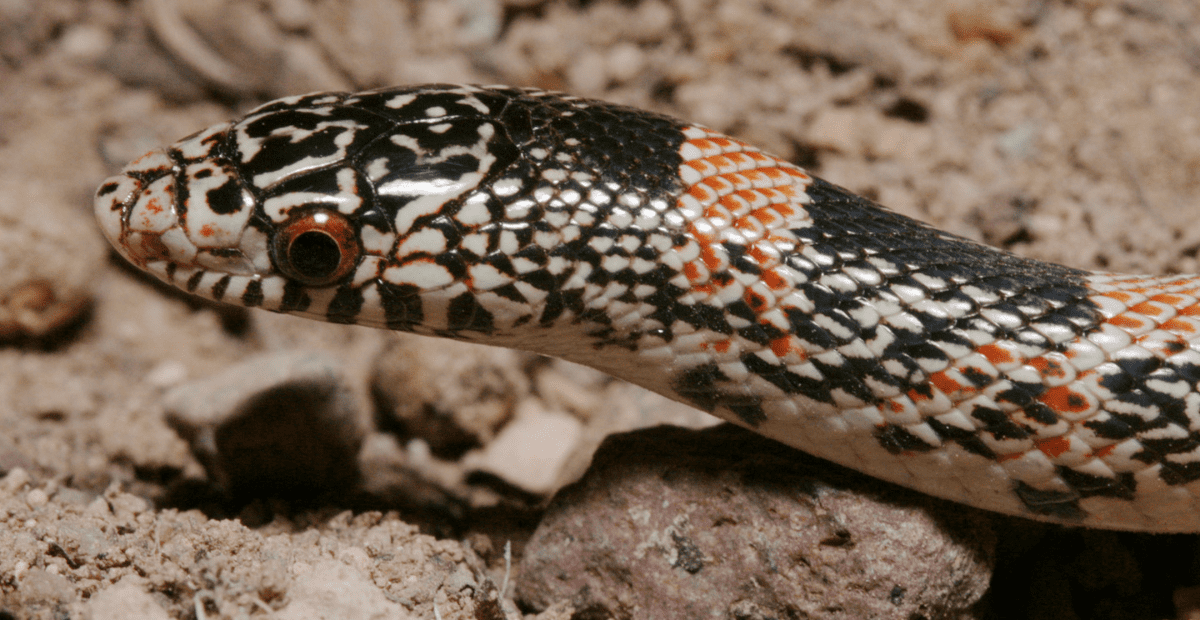The long-nosed snake, or Rhinocheilus lecontei, is a nonvenomous species found across North America. They are often mistaken for the venomous coral snake due to its similar coloration, so be careful, this is another reptile with distinct characteristics and behaviors.
For this blog post, we crafted a comprehensive guide with everything you need to know about the long-nosed snake. It starts by explaining the features that set them apart and later goes over the basics of an animal profile: Habitat and geographic range, behavior, diet, and reproduction.
We are against keeping wildlife as pets, but we figured that the people who are resolved to have a long-nosed snake will (hopefully) google how to properly take care of them. We want them to have the greatest chance of survival whether in the wild or at someone’s home. So we explain everything you need to know about caring for a long-nosed snake.
Lastly, we finish the blog post by going over some frequently asked questions about this species.
Below are some jump links to help you go straight to what interests you more (We don’t like wasting other people’s time).
Jump Links
- Distinguishing Features of the Long-Nosed Snake
- Habitat and Geographic range
- Behavior
- Diet
- Reproduction
- Caring for a Long-Nosed Snake
- Common Questions About Long-Nosed Snakes
At Animals and Hope we write about animals, with the goal of helping people understand their importance by increasing their knowledge about animalia. We highlight endangered species that are not so famous; offer free teaching resources; explain recent and relevant research findings; give ideas on how to help animals; and answer people’s curiosity about the animal world. Here are some of our latest posts:
- Animal Tracking Bracelet: Why You Should Get One
- Research Exposes that Chimpanzees Self-Medicate With Plants
- How many hearts does an octopus have? and why is it three?
- Why Do Flamingos Lose Their Pink? and Why They May Go Extinct
Now, onto what you came here for:
Distinguishing Features of the Long-Nosed Snake

The long-nosed snake is a slender species, reaching lengths of slightly over 3 feet (90 cm). It typically has bands or blotches of black, white, and sometimes red. The belly is cream or yellowish with dark spotting on the sides. One of its notable features is a long, slightly upturned snout. The body bands do not completely encircle the snake, which helps distinguish it from the coral snake.
Habitat
Geographic Range
The long-nosed snake’s range extends from the southwestern United States through northern Baja California and into central Mexico. In the US, you can find them in states like California, Nevada, Utah, Arizona, New Mexico, and Texas.
Their usual habitat consists of deserts, grasslands, chaparral, and tropical habitats below 5400 feet (1650 m). They prefer brushy, rocky areas and you can often see them in sandy soil where they can burrow.
Behavior
This species is primarily nocturnal and shy. When threatened, it may recoil, twist its body, vibrate its tail, and defecate feces and blood as a defense mechanism. It is an excellent burrower and often retreats under rocks or into rodent burrows.
Diet
The diet of the long-nosed snake includes lizards, lizard eggs, small snakes, small mammals, and sometimes birds. In captivity, they may reject rodent-based diets, making them less common in the exotic pet trade.
Reproduction
In warmer regions, long-nosed snakes may lay two clutches of 4 to 11 eggs per year. In cooler areas, they typically lay only one clutch per year. The eggs hatch in late summer or early fall.
Caring for a Long-Nosed Snake
Habitat Setup
To create a suitable environment for a long-nosed snake, provide a terrarium that mimics their natural habitat. Include sandy or loose soil for burrowing, along with rocks and branches for hiding and climbing. Maintain a temperature gradient with a basking spot around 85-90°F (29-32°C) and a cooler side around 70-75°F (21-24°C).
Diet and Feeding
Offer a varied diet that includes lizards, amphibians, and smaller snakes. While people often use rodents for feeding snakes in captivity, some long-nosed snakes may refuse them. Ensure fresh water is always available.
Handling and Interaction
Long-nosed snakes are generally non-aggressive and rarely bite. However, they may release a foul-smelling musk or blood from their cloaca when handled. Handle them gently and infrequently to minimize stress.
Predators and Defense Mechanisms
Natural predators of this species include birds of prey, larger snakes, and mammals. Their primary defense mechanisms include their writhing movements, tail vibrations, and the release of musk and blood to deter predators.
Common Questions About Long-Nosed Snakes
Are Texas long-nosed snakes poisonous?
No, the long-nosed snake is nonvenomous and poses no threat to humans.
What is the defense of the long-nosed snake?
When threatened, the long-nosed snake may writhe, twist its body, vibrate its tail, and release a foul-smelling musk and blood from its cloaca.
Are long-nosed snakes in Arizona?
Yes, long-nosed snakes are in Arizona as part of their southwestern United States range.
What is the Vietnamese long-nosed snake?
The term “Vietnamese long-nosed snake” likely refers to a different species or a misidentification, as Rhinocheilus lecontei is native to North America.
Conclusion
Thank you for being curious about this snake. The more we learn about animals, the more likely we are to understand and appreciate their importance in their respective ecosystem. Also, we can grow more empathy towards them, caring more about their well-being.
In this blog, we write about animals to bring them closer to humans. If you care about snakes you can check out this profile we did on Canada’s rarest snake:

